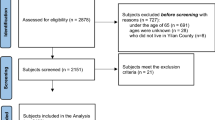Abstract
The aim of this study was to investigate the level of fitness of older people with more than sixty (60) years of age, practicing physical exercise over non-practitioners. The elderly from Santa Fe High (Alta Santa Fe), located in Nova Santa Rosa–Paraná, with 60 individuals, practitioners and non-practitioners of physical activity have participated in the evaluation of physical fitness including tests such as balance, flexibility, and muscle strength. We were unable to detect significant differences between groups of practitioners and non-practitioners of exercise for this study. The physical activity program conducted with this population may still be beneficial for various social and emotional needs but falls short in maintaining physical fitness in these individuals.
Similar content being viewed by others
References
ACSM (2000) Physical fitness program for the ACSM. 2nd edn. Manole Editor
Brown M, Holloszy JO (1991) Effects of a low intensity exercise program on selected physical performance characteristics of 60 to 71 year olds. Aging 3:129–139
Etchepare SL, et al (2012) Seniors: physical fitness practicing gymnastics. Efdesportes virtual magazine. 9 year No. 65 Buenos Aires 2003 Available at: http://www.efdeportes.com Accessed: September 12, 2012 ISSN 1514–3465
Going SWD, Lohman T (1995) Aging and body composition: biological changes and methodological issues. Exerc Sport Sci Rev NY 23:411–449, ISSN 0091–6331
Gonçalves LHT et al (2010) The institutionalized elderly: assessment of functional capacity and physical fitness. Cad Public Health 26(9):1738–1746. doi:10.1590/S0102-311X2010000900007
Kopiler DA (1997) Physical activity in the elderly. Rev Bras Med Esporte 3(4):108–112. doi:10.1590/S1517-86921997000400004
Matsudo SMM (2004) Evaluation of the elderly: physical and functional. MIDIOGRA, FLondrina
Matsudo, SM, Matsudo KVR, Barros Neto TL (2000) Impact of aging on anthropometric, metabolic and neuromotor variables of physical fitness. Braz J Sci Motion 8(4)
Queiroga MR (2005) Tests and measures for assessing health-related physical fitness in adults. Guanabara Koogan SA, Rio de Janeiro
Rebelatto JR, Calvo JI et al (2006) Influence of a program of long-term physical activity on hand muscle strength and body flexibility of elderly women. Rev Bras Fisioter 10(1):127–132. doi:10.1590/S1413-35552006000100017
Ribeiro CCA, Abad CCC et al (2010) Level of flexibility through the sit and reach test from research performed in São Paulo city. Rev Bras Cineantropom Hum Performance 12(6):415–421. doi:10.5007/1980-0037.2010v12n6p415
Rikli RE, Jones CJ (1999) Development and validation of a functional fitness test for community-residing older adults. J Aging Phys Act 6:127–159
Ruwer SL, Rossi AG et al (2005) Balance in the elderly. Rev Bras Otorrinolaringol 71(3):298–303. doi:10.1590/S0034-72992005000300006
Santos DM, Sichieri R (2005) Body mass index and measures of adiposity among elderly adults. Rev de Saude Publica 39(2):163–168. doi:10.1590/S0034-89102005000200004
Shephard RJ (2003) Aging, physical activity and health. Phorte, São Paulo
Silveira, ES (2006) Flexibility in elderly practitioners aerobics. monograph (specialization)—University in the State of Santa Catarina Center 39 physical education, physiotherapy and sports, education
Simons R (2012) Grow strong, live long fitness study with elderly. Retirement home residents independent living. Pertersburg Saint: Available in 2006: http://www.ifpafitness Accessed on: October 7, 2012
Spirduso WW (2005) Physical dimensions of aging. Manole, Barueri
Trancoso ESF, Farinatti PTV (2002) Effects of 12 weeks of resistance training on muscle strength in women over 60 years old. Rev Paul Educ Físicas São Paulo 16(2):220–229
Wells KF, Dillon EK (1952) The sit and reach. A test of back and leg flexibility. Res Q 23:115–118
Zaitune MP et al (2010) Factors associated with global and leisure-time physical activity in the elderly: a health survey in São Paulo (ISA-SP), Brazil. Cad Saude Publica 26(8):1606–1618. doi:10.1590/S0102-311X2010000800014
Author information
Authors and Affiliations
Corresponding author
About this article
Cite this article
Possamai, L.T., Zogo, A., Boni, J. et al. Fitness for elders: A comparison between practioners and non-practioners of exercise. AGE 37, 35 (2015). https://doi.org/10.1007/s11357-015-9772-2
Received:
Accepted:
Published:
DOI: https://doi.org/10.1007/s11357-015-9772-2



